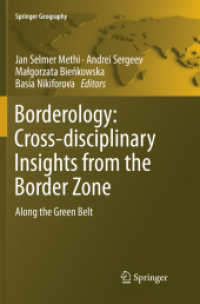Full Description
The Causes and Behavioral Consequences of Disasters brings a public health perspective to the literature, reflecting the increasing importance of the field in both disaster preparedness and disaster response. Arguing that a disaster is not only the event but its aftermath as well, the authors apply salient local content to the study of scenarios ranging from the Cuzco, Peru, earthquake of 1950 to the Columbine school shooting, the Oklahoma City bombing, and 9/11. These case studies form the basis for models of vulnerabilities to disasters and population behavior following disasters, illustrating how careful pre-event planning and coordinated post-event response strategies can minimize the initial damage and negative aftereffects. The Causes and Behavioral Consequences of Disasters will further professional discussion and understanding among a wide range of professionals and students across public health, mental health, education, health administration and policy, social work, and the social sciences.
Contents
Part I: Understanding Disasters and Their Consequences.- Understanding Disasters: The Missing Role of Context.- Broadening Our Conception of Disasters and Their Consequences.- Part II: Why Do Disasters Happen?.- Vulnerabilities and Capacities that Shape the Consequences of Disasters.- A Conceptual Model: Understanding the Causes and Consequences of Disasters.- A Continuum of Vulnerabilities and Capabilities.- Case Study: Venezuela Floods.- Intermittent Stressors.- Case Study: New York City Subway Fire.- Intermittent Protectors.- Case Study: Peru Earthquake.- Part III: What Happens After Disasters?.- What Do We Know About Population Behavior?.- A Conceptual Model: Understanding Population Behavior After Disasters.- Stage One: Group Preservation.- Case Study: Cyclone Rona.- Stage Two: Population Preservation/ Altruism.- Case Study: Typhoid Outbreak Tajikistan.- Stage Three: Internalizing.- Case Study: Columbine High School Shootings.- Stage Four: Externalizing.- Case Study: The Oklahoma City Bombing.- Stage Five: Renormalization.- Case Study: South Africa Traffic Accidents.- The Big Picture: The World Trade Center Terrorist Attacks.- Part IV: Conclusions.- Modifying Our Models.- Conclusions and Implications for Public Health.







